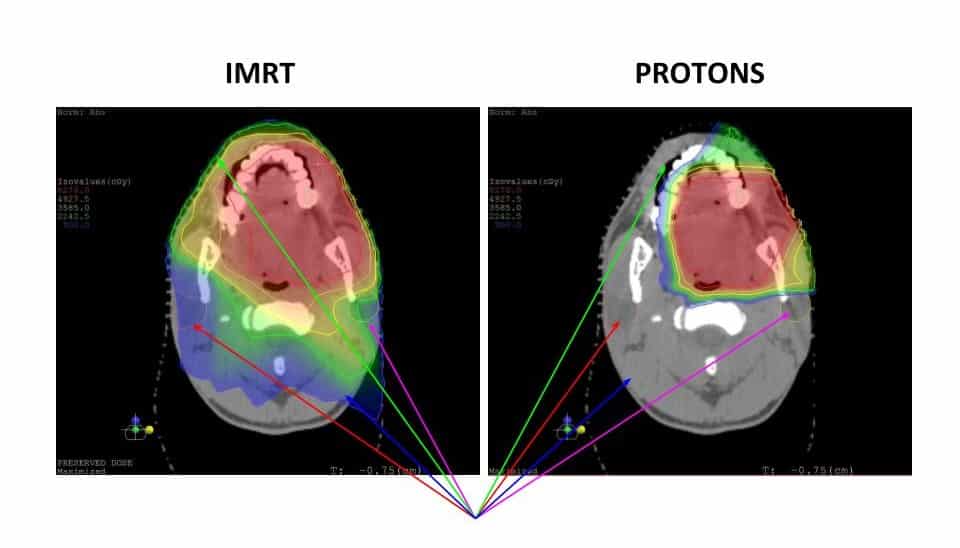
An Educational Series for Informed Patients:
Head and Neck Cancer Proton Therapy – A dramatic difference for some cases.
Today, I’d just like to go into a bit more depth on head and neck cancer treatment and give a real life example.
Radiation the main treatment for many of these cancers. Often it is combined with chemotherapy and while the long-term cure rates of the cancers can be quite high, toxicity from treatment is very significant. In simple terms, this is a life altering treatment. For many cases, I believe strongly that Proton Therapy is and should be the accepted treatment for many cases due to the dramatic ability for Proton Therapy to avoid treatment of structures not at risk for disease, but critical to the successful short-term completion of treatment AND long term quality of life for the patient.
IMRT vs Protons for Head & Neck Cancer Treatment
In the first image below we see representative plans for IMRT vs Protons. Dose are shown in colors from Red (highest), to blue (lowest). Arrows help highlight important regions to compare between the two plans.
As you can clearly see, the Proton Therapy plan is far more targeted and precise. The region at risk for tumor (the red region) looks pretty similar. There are some slight differences in the front of the mouth region in favor of Proton Therapy, but overall, pretty similar – so target / tumor coverage is pretty similar as shown above.Next, let’s look at the parotid glands (red and purple arrows) – these are critical for taste, long and short term salivary function, teeth health, and affect the long term rate of risk of necrosis and damage to the mandible. Simply stated, there is no comparison. The Proton Therapy plan dramatically reduces dose to these critical structures. They are NOT at risk for disease and every single radiation plan by every single doctor is optimized to get doses to these structures as low as possible.
Effect on Need for Narcotics and Feeding Tube
Next we’ll look at a couple of things that can make big difference if accounted for in your treatment. The green arrow points out towards the front right of the mouth / lip region. Dose here causes swelling and bleeding of the lips. Patients struggle to eat and most require narcotic pain medications. The Proton Therapy plan reduces dose to this region – even in this case where the target covered basically the entire mouth. Now this patient probably still will really struggle to eat and likely will need narcotics and maybe a feeding tube even with Proton Therapy, but we need to do things to minimize these risks. Overall, less dose leads to less toxicity and side effects.
Effect on Hair Loss
Finally, let’s look at something most physicians can’t plan for because they have to have dose coming in somewhere – your hairline. The blue arrow points to an area on your neck up near the bump on the lower side of skull. In the IMRT plan, this region receives dose and that “low dose” is high enough to often cause permanent hair loss. If you don’t have access to Proton Therapy, as a physician, you can’t change this. If you don’t have access to Proton Therapy, patients accept this as “expected” and if the hair line changes by an inch or two and the cancer is gone, no big deal. But for some patients it can be avoided with Proton Therapy. Proton Therapy doesn’t spread dose out across the head, it targets the disease and it does so far better than external beam radiation for some cases.
Later this week, we’ll move a little higher and look at doses up near the brain for this case. Learn more about head and neck cancer here.
Dr. Mark Storey MD
Medical Director, Oklahoma Proton Center
